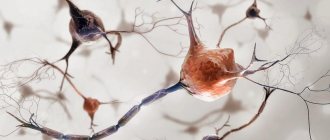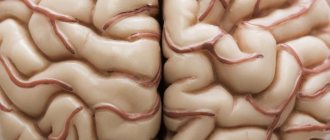Types of people with rigid thinking
How to recognize rigid people? Psychologists have compiled a list of distinctive features of such individuals. Here is the psychological characteristic:
- Such people tend to be stubborn. It is difficult to convince them of anything; they will stand their ground.
- Habits are with them forever: it is unrealistic to undermine the system of their habits created over the years; they remain faithful to them.
- Such people have a high degree of impressionability; something new and unusual causes a storm of emotions in them.
- Suggestible, even too suggestible, such suggestibility is dangerous.
- They cannot correct their mistakes and are not capable of analyzing them.
Such people are attached to their stereotypes, which prevents them from perceiving new trends and knowledge. Changing themselves is a difficult step for them: becoming different, changing ideas, opinions and thoughts will be hard work. The inflexibility of thinking is explained by the assimilation of new things not through one’s own feelings and experience, but with the help of an authoritative opinion.
Rigidity is not always a bad thing: if a person has a moderate “dose” of it, it will help him in defending his priorities. If a person remains true to his life principles, is neat and pedantic, then this cannot be regarded negatively. Moderation is needed in everything, including the manifestation of rigidity.
These people love straightforwardness and specifics, otherwise they begin to lose their temper. They have better mental defense mechanisms and are resistant to stress and external stimuli.
In psychology, there are several types of people distinguished by rigid behavior:
- "Flower". This individual tries to protect himself from the group and has a minimal beneficial effect on its goals. This negatively affects the work of the entire group as a whole and causes tension among its members, and can also negatively affect the mental state of the “flower” himself.
- "Jester." Using this example, it is easy to understand how a useful personality quality, in this case humor, turns into a destructive one. People with this behavior joke without knowing the limits; they perceive even serious questions as a reason for humor. Individuals with this psychological trait are usually cynical and harsh, so it is difficult for them to integrate into the team. The members of the group, which includes the “jester,” are tense and afraid to say something that might cause ridicule.
- "Grumpy." Rigid behavior manifests itself in devaluation of the environment. The individual stops seeing positive aspects and responds to any changes in the environment with a negative reaction. Such people create problems for group members because they can kill all the enthusiasm with their complaints and negativity.
- "Terrorist Talker." Individuals with this type of rigid thinking are very sociable, however, they have their “dark” sides. They strive for power and demand constant attention to their person, thereby alienating group members.
- "Conspirator". Conspirators do not pay attention to the rest of the group during discussions. These individuals often create their own isolated associations. This behavior negatively affects the group and can lead to its disintegration.
- "Doubting Thomas". A great skeptic who does not believe in the success of the group. Such an individual is cynical and often in a gloomy mood. His rigidity extends to everything around him, unlike the Grumpy, who has a negative attitude towards one or two issues.
In psychology, rigidity of thinking is assessed as a negative character trait of a person, since it creates some problems in group or individual behavior. However, in moderation, it can be beneficial. Thus, rigidity is the key to success in such professions as accountant, assembly line worker, and dispatcher.
Positive aspects of rigidity
The dictionary of psychology characterizes a rigid person as a subject who is little changeable even under the influence of powerful external influences and is incapable of self-regulation.
Moderately expressed rigidity of a personality expresses the invariability of interests and attitudes aimed at defending one’s opinion, at the activity of a position, which only intensifies under the influence of external forces. She is practical, precise, true to her principles. Such people are resistant to stress because they are less susceptible to environmental changes.
Rigidity also has 3 different main stages of severity, although it never progresses to further stages:
- Stage 1 is a strict perception that makes a person persist in his path and be close to other things.
- 2 – ego protection.
- Stage 3 is part of a person’s personality. Its manifestations can be observed even in cognitive processes, that is, in thinking and understanding the world around us.
Three main stages of its development are studied:
- rigidity as a neurologically determined feature of individual perception, leading to premature closure;
- rigidity as a defense mechanism against ego-involving stimuli;
- Rigidity as a manifestation of basic personality variables observed in the cognitive, social, and perceptual domains.
Rigidity, which is described in the first stages of development, can be useful for the individual. It makes it resistant to negative environmental influences, allows you to defend your opinion and position, and show non-conformism.
Moderately rigid people are less susceptible to stress, panic, and are emotionally more stable than people with flexible and emotional thinking.
Learn to deal with your initial reaction
What usually happens when plans go wrong?
The first reaction is a wave of emotions: aggression, irritation, indignation. This reaction is involuntary, instinctive.
Realize that this is just a reaction, let the emotions pass through you, balance yourself and make a conscious choice on how to act in this situation.
With experience, when you learn to be flexible, you will not react. You will not have an emotional outburst or an acute reaction to changing circumstances.
Example. Your computer has broken down and you need to work. If you can’t resolve this issue in the near future, think about why you need this situation.
On the one hand, you are left without the opportunity to work, and you have a lot to do.
On the other hand, maybe this is just an opportunity to do what you have long wanted, or simply think about your goals and, perhaps, reconsider them in a calm environment.
The main point here is this: you DO NOT fall into the victim state: “How can this be? What to do now?"
You take the necessary measures in the current situation, do everything that depends on you and switch to another task while you wait for the issue to be resolved.
Types of higher nervous activity in humans
Back in the 4th century. BC, the ancient Greek physician Hippocrates, observing the behavior of different individuals, identified 4 types of temperament.
- Sanguine – strong, seasoned, labile.
- Choleric – strong, uncontrollable, hot-tempered, easily excitable.
- Phlegmatic - strong, calm, with low lability of nervous processes, inert;
- Melancholic - weak, easily tired, with low performance.
In the modern world, the concept of the typological accessories of the nervous system of both humans and animals has become one of the key aspects of I. P. Pavlov’s teaching on higher nervous activity.
Depending on this specificity, I. P. Pavlov defines 4 types of higher nervous activity, the identification of which is based on various combinations of three leading indicators:
- forces - the intensity of the processes of excitation and inhibition;
- poise - balance or predominance of the intensity of the processes of excitation and inhibition;
- mobility - the speed of replacement of the process of excitation with inhibition and vice versa.
- The first type is “living” and coincides with the sanguine person of Hippocrates. It is characterized by increased intensity of nervous processes, their balance and extreme mobility. The transition from one conditioned reflex to another occurs quickly.
- The second - “unrestrained”, is identified with the Hippocratic choleric. It is distinguished by the intensity of nervous processes, the predominance of nervous excitation over inhibition, and their high lability.
- The third is “calm” and coincides with the phlegmatic person. It stands out for the intensity of nervous processes, their balance, and low lability. Inactive, highly excitable, slow. Reacts adequately to strong external influences and is balanced.
- The fourth is “weak”, identical to the melancholic. It manifests itself as a low intensity of nervous processes and their reduced lability. In this type, both excitation and inhibition are weakened, but inhibition is to a superior degree. The formation of conditioned reflexes is difficult, and prolonged or severe irritation causes rapid nervous exhaustion.
In the 20s of the twentieth century, guided by the idea of two signal systems that form a person’s idea of the environment, Academician I. P. Pavlov created a typology of higher nervous activity inherent exclusively to the human personality.
Based on the predominance of one or another signaling system, I. P. Pavlov identified:
- Artistic type – individuals with a dominant first signaling system. They are characterized by imaginative thinking, heightened emotional background, and developed imagination. They predominate among creative figures.
- Thinking type – individuals with a priority of the second signaling system. They are distinguished by their predominant abstract thinking, analytical mind, and ability to systematize information. These are scientists.
- The average type is the human majority, people with both equally developed signaling systems.
- Genius type - persons with extremely developed signaling systems. A very rare type.
The doctrine of the types of higher nervous activity is an important link in understanding the logic of the emergence of such psychological personality traits as temperament or character. Features of the type of higher nervous activity and temperament represent the natural core of the individual uniqueness of the individual.
Rigid person syndrome.
Patient, 60 years old. Entered the 1st neurological department in November 2011. Complaints upon admission: intense pain in large joints, a feeling of “tightening with a tourniquet”, stiffness of the muscles of the limbs, loss of the ability to self-care. HISTORY: Ill since May 2011, when pain appeared in the left arm, after 2 weeks pain and weakness appeared in the right foot. In June 2011 urinary retention was noted, stiffness and pain in the extremities appeared and increased. He was hospitalized at City Clinical Hospital No. 23, where he stayed for a month with a diagnosis of polyneuropathy of exogenous origin with tetraparesis, acute urinary retention. . The examination revealed multiple disc herniations at all levels, compression of the spinal cord at the C3-C4 level, and degenerative changes in the spinal cord. A permanent urethral catheter was installed. The patient was treated with metipred at a dose of 1000 mg intravenously every other day. Upon discharge, it is recommended to take sirdalud, PC-merz, and berlition. In September 2011, he was hospitalized in the urology department of City Clinical Hospital No. 7 in order to resolve the issue of the possibility of removing the urethral catheter, from where he was discharged with a diagnosis of Neurogenic bladder. Chronic prostatitis. Indwelling urethral catheter. Myeloradiculopathy due to spinal stenosis. The neurosurgeon recommended anterior decompression at the cervical level with spinal fixation, which the patient abstained from. According to relatives, the disease was preceded by long-term alcoholism. In May, coding for alcohol dependence was carried out. The existing neurological symptoms were regarded as polyneuropathy of toxic origin. ENMG was performed, which revealed multiple mononeuropathies, but the muscle response was not studied. Consulted at the Department of Neurology of the MMA named after. Sechenov, rigid person syndrome was diagnosed. Therapy with baclosan and relanium was prescribed. During treatment, pain decreased slightly and muscle tone decreased. However, intolerance to baklosan was revealed, in the form of a hallucinatory syndrome, after which the drug was discontinued. The disease progressed steadily, with increasing spasticity, muscle pain, and limited mobility in large joints. Stopped moving and caring for himself. To select therapy and further examination, he was admitted to the Federal State Budgetary Institution Clinical Hospital No. 1. In addition, the anamnesis includes stroke in the VBS (May, September 1996), hypertension, chronic gastritis, chronic pancreatitis. Objectively upon admission: General condition is relatively satisfactory. Takes a forced position, lying on his back with his head thrown back, limbs bent at the joints with the formation of contractures of the elbow, shoulder, and knee joints. Movements in the limbs and trunk are practically absent. The skin is pale. Facial hyperemia. In the area of the sacrum and heels there are bedsores. There is no swelling. Contractures in joints - elbows, shoulders, knees. There is harsh breathing over the lungs, dry scattered wheezing. Heart sounds are muffled, the rhythm is correct. Blood pressure 105/70mm Hg. Art. Pulse 72 beats. per minute The abdomen is soft and painless on palpation in all parts. Urination through the catheter, stool is normal. In neurological status: Consciousness is clear, in contact. Intellectual-mnestic decline. FMN pupils D=S. Photoreactions are preserved. Full movement of the eyeballs. Horizontal nystagmus. The face is symmetrical and hypomimic. Tongue in the midline. Rough axial rigidity with retention of body weight when the head is supported on the doctor’s hand at an angle of 45 degrees, there is practically no active and passive flexion in the thoracic spine due to rough tension in the muscles of the thoracic and lumbar spine. Does not turn independently within the bed. Tendon reflexes are evoked, but the implementation of the reflex in the hands is limited by the rigidity of the muscles, both extensors and flexors, including the forearm. There is muscle rigidity in the legs (hips), but the feet are set in extension (big toe set). There are no convincing pathological signs. The tone in the legs is increased, but not as significantly as in the arms. In the blood: acceleration of ESR up to 35 mm/h; anemia (Hb-106g/l); leukocytosis up to 10.6x109; C-reactive protein is strongly positive; In urine: leukocyturia - 30-40 in the field of view, bacteriuria. In the cerebrospinal fluid: protein-cell dissociation (protein-0.7 g/l, cytosis 3/3 (neutrophils 2, lymphocytes 1). During bacteriological examination of the cerebrospinal fluid, microflora was not isolated. To clarify the diagnosis of rigid person syndrome, a blood test was taken for antibodies to GAD. Glutamate decarboxylase (GAD) is an enzyme that is involved in the formation of gamma-aminobutyric acid (GABA), it is an inhibitory neurotransmitter of the nervous system. This enzyme is found in nerve cells (neurons) and in the beta cells of the pancreas. Increased levels of antibodies to glutamate decarboxylase are characteristic of diseases of the nervous system such as Mersch-Woltmann syndrome, epilepsy, Lambert-Eaton syndrome, cerebellar ataxia, as well as stiff man syndrome. Stiff-man syndrome is a poorly studied pathology. It is known that rigidity in this disease begins with axial and proximal sections, gradually spreading to other parts of the body.The EMG initially registers increased bioelectrical activity of the muscles at rest; During movement, no specific phenomena are noted on the EMG. Men get sick more often. The onset of the disease occurs between the ages of 30 and 60 years. Death occurs after 4-16 years (usually from cachexia). Based on the results of a blood test for AT-GAD = 33 (the norm is less than 1), a diagnosis of rigid person syndrome was made. A course of plasmapheresis and CS hormone therapy was carried out in a dose of at least 100 mg according to the e/d regimen for 14 days, Clonazepam 2 mg 3 times. After the treatment, the intensity of the pain syndrome decreased, muscle stiffness decreased, and minimal movements appeared in the torso and limbs. The patient was discharged home, where he continued hormone therapy in tablet form, as well as exercise therapy, massage, and breathing exercises. It was supposed to repeat the blood test for AT-GAD after 2-3 months of this therapy. Unfortunately, the patient developed congestive lower lobe pneumonia, from complications of which he died 2 months after discharge from the hospital.
Reasons for the formation of this trait
Poor mental mobility can be congenital or socially conditioned. In psychology, it is generally accepted that rigidity of thinking is caused by factors such as:
- genetic predisposition (for example, a child inheriting a phlegmatic type of temperament from parents);
- character accentuations;
- low speed of mental processes, weak reactivity of the nervous system, disturbances in the process of its functioning;
- low rate of mental activity due to biochemical changes in the brain;
- endocrine disorders;
- age-related changes in the psyche, manifested in the form of conservatism in views and habits;
- mistakes in family education, many prohibitions and punishments, increased demands on the child;
- coldness of parent-child relationships;
- unfavorable psychological situation in the family;
- intrapersonal emotional conflict;
- exposure to psychotraumatic factors, stress, depression;
- disappointment in personal life;
- lack of opportunity for self-realization;
- failures in professional activities, tense interpersonal relationships in the production team;
- neurasthenia, hysteria, neurosis, psychosis;
- autism, narcissistic personality disorder, Asperger's syndrome;
- encephalitis, meningitis;
- radiculitis, cervical spine injuries, osteochondrosis;
- Parkinson's disease, stroke, brain abscess;
- poor nutrition;
- alcohol or drug addiction;
- chemical poisoning;
- injuries and organic damage to the brain or spinal cord.
In psychology, it is believed that the foundation for the development of such a quality as rigidity is a combination of psychophysiological prerequisites with social factors.
The main causes of rigidity
Reflection - what is it in psychology, definition
The causes of rigidity should be considered holistically. As a rule, its appearance is associated with many factors, some of which could have occurred in childhood. There are two types of causes of rigidity:
- Psychophysiological;
- Social.
Psychophysiological reasons
- structure of the central nervous system;
- congenital or acquired diseases of the central nervous system;
- genetics or hormonal imbalance;
- paranoia;
- psychosis, etc.
Social reasons
- poor nutrition;
- drug, chemical or alcohol poisoning of the body;
- injuries of the skull, especially the temporal and occipital parts;
- frequent personality conflicts;
- split personality;
- problems in personal life;
- inability to realize oneself in the professional sphere.
Alcoholism contributes to the emergence and development of rigidity
Rigidity of thinking
In the process of self-development of one of the options, we always mean independence of thinking, what is called heuristic, creative thinking, when we ignore generally accepted stereotypes, models and clichés, trying to embrace everything with our own mind and form an independent individual perception of the world, and based on this perception, model creative behavior that makes us more effective at solving problems.
However, why are stereotypes needed, why do they exist at all? Following stereotypes as ready-made models is an energy-saving technology when we spend as little as possible. For most people, the mental and energy resources do not always allow them to use creative thinking; there is simply not enough of it to carry out such costly activities. That’s why we all show rigidity in our attitudes at times.
Unconsciously, a person avoids a heuristic approach and tries to use ready-made models in life, thereby preserving resources for his life support and pressing problems that he has in life. Therefore, the problem of free thinking, creativity and openness to new experiences is not always a problem of a person’s choice, it rather has to do with psychophysiology.
Rigid thinking leads a person to other types of rigidity, including motivational and emotional rigidity. Based on the interpretation of what is happening, a person chooses goals, a certain set of roles, and gives everything a strict and unambiguous assessment.
For example, the whole life of a rigid woman can be completely reduced to the role of a mother; she has adopted the values and attitudes of her parental family and devoted her whole life to their implementation, without the critical assessment and revision that reality often requires. This woman may not see other sides of herself, but if she did this, she would see herself as a beautiful woman or businesswoman, and, of course, would be able to realize herself more fully. However, rigidity of thinking does not allow this to be done, and emotional rigidity convinces a person that happiness is found only on this once chosen and correct path. A person believes that he should be happy, but in reality this feeling is not there, and he literally does not allow himself to look at life differently.
A rigid personality is capable of achieving good, even high results in the chosen field, because he puts all his efforts only in this direction, without changing it or getting scattered. Here, rigidity is close to perfectionism, when a person spends resources disproportionate to the result to do everything perfectly. Having received the result that the rigid person so diligently strived for, he will expect recognition from others, but may remain reduced, unmanifested in many other areas. That’s why rigidity leads to a whole list of problems, including problems of self-esteem, relationships, exhaustion, overvalued ideas, and separation from reality.
A less rigid person will be able to try new things, learn from mistakes, gain experience, develop comprehensively, this will allow him to achieve results not only in his chosen area - thanks to a whole list of mastered means, but also in other areas. As a result, he will gain greater satisfaction and life experience, and will be able to express himself more fully. An extremely rigid person, observing the positive results of such not always ideal and correct actions, may experience envy and disappointment, because he did everything as he should, and it is he who deserves the approval of others for the result!
Of course, it is possible to develop flexibility of thinking, but this will require the restructuring of neural connections, which sometimes requires enormous effort and time. Having developed flexibility, a person will be able to push his boundaries, expand his personal living space and horizons, and be open and accessible to the outside world.
Allow yourself to be imperfect, reconsider your previous attitudes by asking why it should be this way. Correctness is not an indicator of high moral qualities, but only inflexibility, which does not give rise to pride and will prevent you from achieving results. Raise the deferred desires that you have long rejected, consider them as a possible resource, ask yourself what will be better when you allow yourself to do what you want. If you are able to deviate from the norm, you will appear to yourself and others as a more free, lively and natural person.
"Wittgenstein's ladder"
It sounds simple, but in reality it is very difficult to get rid of rigid thinking and you should contact a specialist who will create an individual treatment program for you.
The problem with rigidity is that no matter how much the patient wants to get rid of the desire to follow the rules, his inner “I” protests. The subconscious convinces him that by overstepping his rules, a person will turn into an unprincipled person, capable of any base act.
Patients who have overcome their rigidity say that in reality it turns out that there was no rigidity, only honor, integrity, beliefs and faith in traditions on an inflated scale.
To convince yourself to get rid of the belief in the correctness of your actions, repeat to yourself that truth is a relative concept; you may have misunderstood it when you heard or read it. Are you sure that your actions, actions and their motives are the truth? And in our impermanent world, is it possible to be sure that the truth remains and is understood in the same way as it was an hour, a day, a month ago?
Convince yourself that truth is unknowable.
Accept for yourself and come to terms with “Wittgenstein’s ladder”, which sounds like this:
"Wittgenstein's ladder"
It sounds simple, but in reality it is very difficult to get rid of rigid thinking and you should contact a specialist who will create an individual treatment program for you.
The problem with rigidity is that no matter how much the patient wants to get rid of the desire to follow the rules, his inner “I” protests. The subconscious convinces him that by overstepping his rules, a person will turn into an unprincipled person, capable of any base act.
Patients who have overcome their rigidity say that in reality it turns out that there was no rigidity, only honor, integrity, beliefs and faith in traditions on an inflated scale.
To convince yourself to get rid of the belief in the correctness of your actions, repeat to yourself that truth is a relative concept; you may have misunderstood it when you heard or read it. Are you sure that your actions, actions and their motives are the truth? And in our impermanent world, is it possible to be sure that the truth remains and is understood in the same way as it was an hour, a day, a month ago?
Convince yourself that truth is unknowable.
Accept for yourself and come to terms with “Wittgenstein’s ladder”, which sounds like this:
Operating principle of cogeneration plants
Depending on the principle of operation, there are several types of cogeneration stations. Let's consider cogenerators based on gas piston units. Combustible gas of the required parameters is supplied to the gas piston engine. During the combustion of fuel, mechanical energy is generated, transmitted through a single shaft to the generator and converted into electrical energy of standard quality parameters.
When an internal combustion engine operates, a large amount of heat is released, which can be recovered using special equipment and then used. At the same time, no additional amount of fuel is consumed to obtain this energy - this product is a by-product in the technological process of generating electrical energy. The main sources of associated heat during the operation of a gas piston power plant:
- heat of cooling water (“jacket” of engine cooling);
- waste heat (exhaust gases).
These sources can be used to obtain thermal energy (heat recovery), thereby regulating the temperature and volume of energy resource production, as well as the volume of installed auxiliary equipment.
The heat recovery system from cogeneration plants makes it possible to obtain associated thermal energy of the required parameters using heat exchangers and waste heat boilers, which remove heat from heated parts and environments. The generated thermal energy is supplied to the existing heat supply system of the enterprise (cogeneration). If associated heat is not used, thermal energy is discharged into the atmosphere.
A schematic diagram of the technological process of heat recovery from gas piston units is shown in the figure below.
Schematic diagram of the cogeneration installation device
The thermal (thermal) efficiency of the GPU is approximately on the same level as the electrical one, providing almost the same output parameters for electrical and thermal power, regardless of whether a cogeneration plant of low, medium or large power is considered.
The operation of the heat recovery system of a gas piston unit is organized by several thermal circuits. An enlarged diagram of the technological process of operation of GPU circuits with a nominal electrical power of 2000 kW to ensure heat recovery from heat exchangers and waste heat boilers is shown in the figure below.
The given process diagram shows exclusively the hydraulic connection of the MWM gas piston unit.
The following contours are indicated in the figure:
- engine cooling circuit;
- mixture cooling circuit;
- heating circuit;
- emergency cooling circuit (system).
The water temperature at the outlet of the heat recovery system of the cogeneration plant is 90°C; at the inlet, the water arrives at a temperature of 70°C. 50% of the heat is obtained by cooling the engine using ethylene glycol/water heat exchangers, while the coolant is heated by 10°C (from 70°C to 80°C). The remaining 50% of the heat is produced by cooling the exhaust flue gases from 500°C to 120°C in the recovery boiler. At the same time, the coolant heats up by another 10°C (from 80°C to 90°C).
When operating a gas piston power plant, generating electrical energy is a priority. The production of thermal energy (heat cogeneration) is proportional to the degree of load of the machine (the amount of electricity generated). Russian-made cogeneration plants are less common on the small-scale distributed energy market, but have a similar operating principle and conditions.
How does rigidity manifest itself?
After considering the theory, it becomes interesting who is characterized by rigidity in everyday life. Maybe such people surround us, but we have no idea about their characteristics? As a rule, this is true. After all, this property most often manifests itself only partially, turning people into stubbornness only in one aspect of life. A total of six psychotypes endowed with this trait were identified.
1. A sociable person who loves to talk. Personalities of this type have well-developed speech, a rich vocabulary and the ability to communicate. At the same time, they are distinguished by their callousness and “deafness” in relation to other points of view. They say about such people: “there are only two opinions - mine and the wrong one.” They do not intend to change anything in their behavior, since the primary task is to express their own point of view and demonstrate their abilities.
2. A pessimist who is dissatisfied with life. This person is fixated on the negative; every mistake or failure is experienced for a long time and painfully. Any positive thoughts and feelings are practically inaccessible to him, and new opportunities pass by unnoticed by him. He enthusiastically complains about his problems, categorically ignoring the feelings of other people.
3. Distrustful and categorical. He is distinguished by cynicism and straightforwardness. Gets satisfaction from “speaking the truth.” He considers himself straightforward and truthful, but in reality he is a callous person who does not know how to sympathize with others. Not prone to empathy. This rigid behavior is typical of a leader.
4. Greenhouse plant. Prefers solitude and does not delve into what is happening. He is betrayed by arrogant behavior, wariness and reluctance to communicate. Believes that other people are capable of bringing chaos into his measured way of thinking and communication with them promises nothing but trouble.
5. A demonstrative joker and a merry fellow. He perceives everything that happens around him and in the world through the prism of skepticism and fatalism. He is distinguished by irony and cynicism, prefers black humor. Strives to be the center of attention, but with his behavior he pushes away and deeply hurts people without noticing it.
6. Gray cardinal. This rigid person is one who looks down on others, prefers to surround himself with selected confidants, and is prone to intrigue. Rigid behavior is expressed in isolation and the desire to hide one’s feelings, while happy to discuss other people’s secrets. He prefers not to pay attention to the consequences of his behavior.
Signs of rigidity can be observed among work colleagues, relatives and political figures:
Inability and unwillingness to change the chosen line of behavior, regardless of the need; Stubbornness and blind persistence in defending one’s own point of view; Obsession with an obsessive idea even contrary to common sense; The need to perform daily rituals, or in connection with recurring situations; A predetermined pattern of behavior that a person diligently follows, a trained sequence of actions; The desire to insist on one’s own and the desire to leave the last word in the dispute only to oneself; Tendency to dominate any conversation, inattention to interlocutors; Lack of flexibility of behavior in critical, stressful situations.
The listed signs may occur partially, and the presence of one does not interfere with the manifestation of other excellent personality traits. Difficulties with communication arise when a person has several points at once. The more areas rigidity affects, the more difficult the interaction with its owner.
Rigid mentality is quite common, and this trait can manifest itself in many people. In small doses, it is even useful, as it helps maintain internal balance and increases stress resistance. However, to a large extent, rigidity interferes with normal life and communication. To overcome the problem, you need to consult a psychologist. Specialists conduct systematic sessions with clients aimed at enhancing flexibility and plasticity of perception.
Rigidity - what is it?
The term “rigidity” translated from Latin means inflexibility. In Russian, this definition is not always used for its intended purpose, confusing it with others with similar properties. In America, it is used exclusively in psychology and neurology. Rigidity is a person’s inability to adequately respond to changing circumstances.
Rigid people are often called stubborn, incapable of leaving their comfort zone, and zealously defending their positions in life. At the same time, defending your habits can take place not only in dialogue with your interlocutor, but also in various life situations, even contrary to common sense. People who have such a pronounced character trait as rigidity are pedantic, with high self-esteem, overly straightforward, stubbornly defending their own interests.
For your information. In fact, rigidity of thinking is present to one degree or another in every person. In some it is expressed moderately, in others this trait has a leading function in character.
A person with a moderately rigid character type has a flexible mind, he is inventive, rational, but is completely unable to adapt to different life situations. He is very punctual, precise in expressing thoughts, specific in requests and judgments. Rigid people are enraged by amorphous people, irresponsible, sloppy, who cannot clearly plan not only their immediate future, but even the coming day.
Rigidity is a sign of stress resistance in psychology, due primarily to the fact that people with this type of character are less subject to public opinion. They don’t care how their neighbors, friends or strangers live, the main thing is that nothing affects their sense of personal comfort. In some cases, they are able to begin to impose their opinion.
Types of rigidity
Since rigidity affects personality in different areas of life, psychologists use a classification to determine a specific rigid personality type.
✔ Affective/emotional rigidity. Characterized by an emotional response to external stimuli. It manifests itself as obsession. Such a person is capable of endlessly replaying events in his thoughts, reliving what happened over and over again. At the same time, his emotional response does not weaken, as usually happens, but has a constant intensity. Such behavior is fraught with the appearance of obsessive states.
Affective rigidity is constancy in feelings, emotions and their manifestations. It is precisely this type that includes monogamous people who are unable to “cheat” on their long-lost partner.
In psychology, emotional rigidity is a repeating pattern of behavior, predictability of reactions and uniformity of emotions.
✔ Motivational rigidity. More striking than others. It is these people who are usually called “stubborn”. They are conventionally divided into three types:
- Failed, disappointed. Having once become a victim of circumstances, they give up on themselves for the rest of their lives, considering themselves losers. A characteristic feature is the reluctance to make efforts to change one’s life and improve its quality.
- Stubborn. People of this type go straight ahead, not noticing the open gate. They do not know how to show flexibility and change the intended route, as well as abandon the set goal. Following the chosen method, which turns out to be ineffective, they fail over and over again, but continue to strive to achieve the goal, repeating fruitless attempts.
- Sloths. These people once decided that they did not need a successful life. They go with the flow, perceiving any life-changing circumstances as a disaster.
✔ Cognitive rigidity. Characterized by inertia of perception and thinking. A person has no need to change the existing picture of the world, even if it is obviously incorrect.
Cognitive rigidity is the inability to be creative in any area. The destiny of such people is to think in templates, clichés and standards. This kind of trait makes it difficult to perceive new information if it does not coincide with old patterns. Therefore, everything that goes beyond stereotypes is considered unsuitable and harmful.
Types of rigid behavior
There are several types of behavior of rigid personalities:
Individuals who are called “terrorist talkers”
Such people have increased talkativeness, but the disadvantage of this is that they try to grab attention and become the only center of any conversation.
There are those among us who are always dissatisfied with everything, they don’t like anything and it is impossible to please them in anything. People who are called "Doubting Thomas". All their rigidity is aimed at individual situations and thoughts. People are “flowers”. Such a person gradually separates from society, ceasing to make his contribution. People are “clowns”. The sarcasm and irony of these individuals know no bounds or sense of proportion. Their style is to ridicule absolutely everything in the world. People are “conspirators”. They “split” the team into separate groups, which begin to conflict over time, which leads to a gradual breakup of the team.
Today in psychology there are several types of rigidity, which include:
- cognitive;
- affective;
- emotional;
- motivational.
Let's look at each of the varieties for a more detailed understanding of this phenomenon.
Cognitive
Cognitive rigidity is the difficulty in restructuring perception from one question to another, from changing one topic to another, and from completely changing one picture of the world to another. Many subjects live in their own exclusive reality, categorically refusing to create a new picture of the world, even if it is required by certain conditions and new information that displaces the old one. People with cognitive rigidity will act in certain situations and solve certain problems only according to their old and proven patterns.
Affective
Affective rigidity presupposes the presence of certain responses in the human consciousness. This variety implies the affectivity of certain responses to changing emotional objects.
Emotional
Emotional rigidity implies difficulty in restructuring the system of motives in certain life circumstances. At the same time, circumstances require restructuring, plasticity and behavior change.
Many scientists argue that emotional rigidity is a kind of “stable emotion” to everything, an unchanging reaction. It turns out that despite the regular change of circumstances or situations, the individual continues to react to them in the same way, without changing his emotions. That is, no matter what happens, there will be no change in the emotional state.
Motivational
Motivational rigidity is a type that involves stagnation of a person in his own reality and a complete reluctance to change monotony. That is, a person categorically refuses to burden himself with this kind of tasks in order to adapt to the new world and information. This also includes the fact that the individual does not want to change the usual ways of satisfying his needs, completely “trusting” the old ones.
What it is?
Psychologists have defined rigidity as “resistance to acquiring new behavioral patterns by maintaining old and maladaptive styles of behavior.” It is also seen as an essential component of dysfunctional, that is, negative perfectionism.
Rigidity may manifest itself as persistence and an inability to change habits, an inability to change concepts and attitudes once developed and supported by empirical experience.
A specific example of rigidity is “functional fixedness,” which is difficulty in understanding new uses of already familiar objects. That is, a person cannot use, for example, a knife to perform functions other than cutting vegetables.
Rigidity in psychology implies the complexity, unpreparedness or complete inability of the subject to change the intended program of activity in new situational conditions. This is the ability of a person’s psyche and character to firmly maintain a given attitude of consciousness.
A rigid person is not inclined to change his habits. He is stubborn and tries to defend his tactics in solving everyday problems. He is impressionable and retains his emotional state for a long time. People around him must make a lot of effort to distract him from a super-valuable idea or convince him.
Disadvantages of Rigidity
But rigidity has many more disadvantages. With pronounced rigidity, the person becomes narcissistic and very conflicted, and passion for some activity or hobby is put at the forefront of activities, overshadowing everything else. Most often, these signs appear in patients with mental illness.
In a situation where rigidity is expressed to an extreme degree, the person, on the contrary, is observed to be careless and irresponsible. Excessive activity alienates others, and most do not understand the ardent desire to achieve a goal.
Increased rigidity is most often accompanied by emotional instability and paranoia. Individuals are susceptible to obsessions, sometimes overly aggressive and unable to establish contact with the outside world.
In life, mental rigidity prevents a person from being simply happy, since he often does not allow himself small pleasures, considering short-term desires a waste of time and effort.
Manifestations of mental rigidity in humans
What is charisma in a man - the definition of the word, how to become like that
Rigidity can be an innate character trait or an acquired one. In both the first and second cases, this is not a deviation from the norm of mental development, if the rigidity has not acquired a pathological character. This problem is not so much a public problem as an individual one. Nowadays, there are more and more people with pronounced manifestations of rigidity. People diagnosed with mental rigidity are not required to register with psychiatric hospitals. They exist calmly in society, but it is quite difficult for them to adapt to new living conditions, to a new team at work, to any acquaintances, etc.
Rigidity can be a congenital character trait or acquired
The first manifestations of rigidity in a person are aggression and a high level of anxiety. A person who is not able to quickly navigate non-standard life situations, who is not able to adequately perceive new circumstances, begins to enter a state of stress. At the same time, he experiences stress not because of his perception of the situation, but because this situation occurred in his life.











